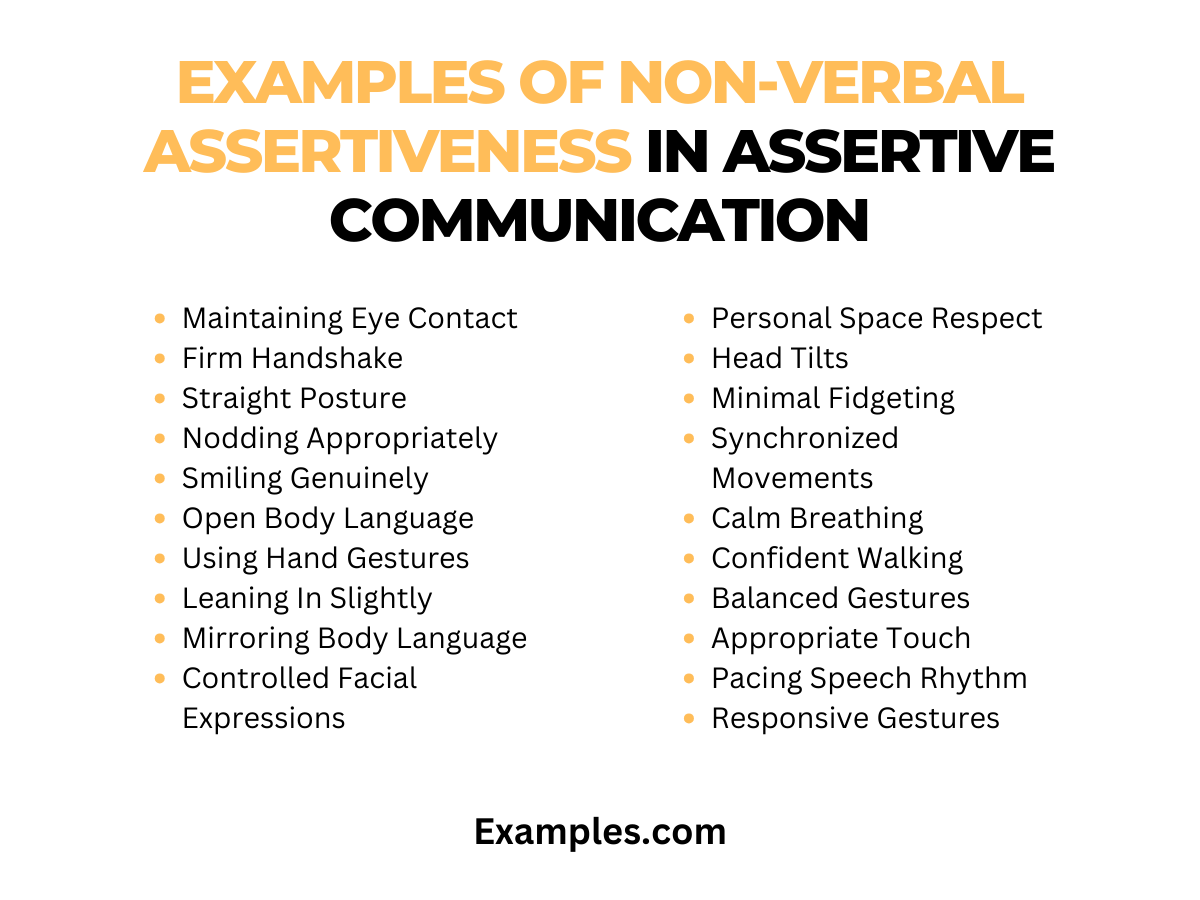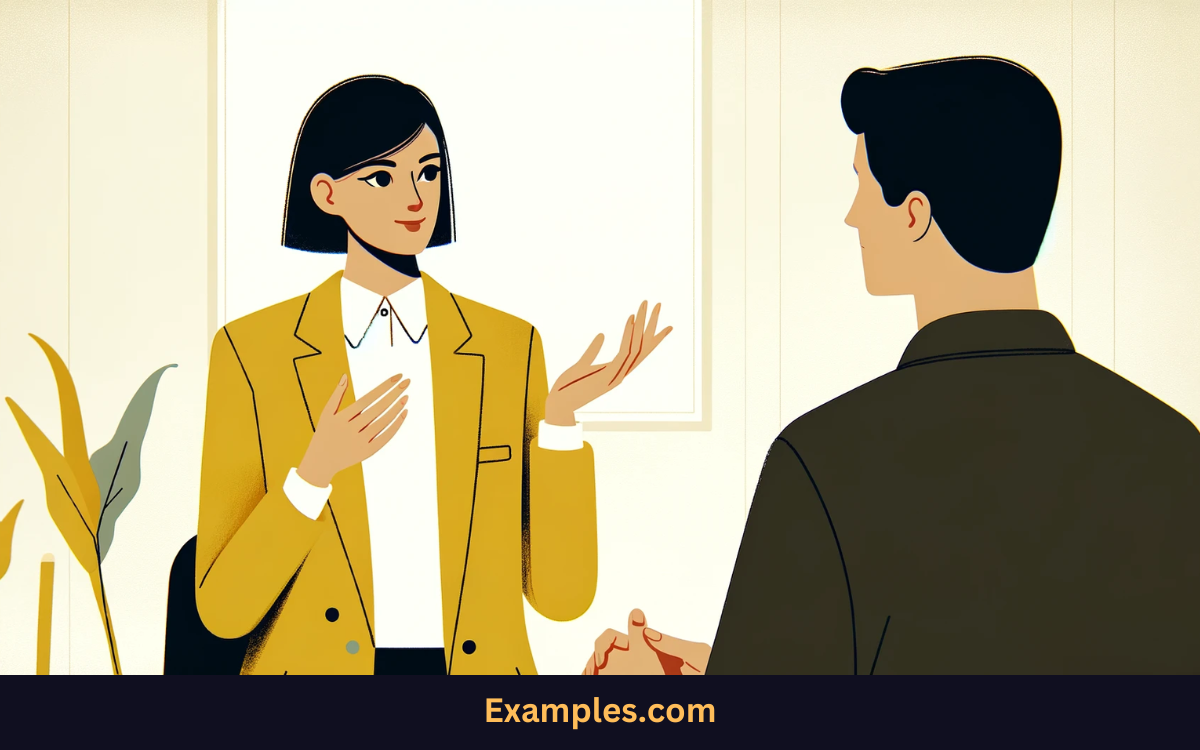19+ Non-Verbal Assertiveness in Assertive Communication Examples
Non-Verbal Assertiveness in Assertive Communication plays a pivotal role in enhancing interpersonal skills. This guide delves deep into the subtleties of non-verbal cues and how they fortify assertive communication. Understanding body language, facial expressions, and tone can profoundly impact how messages are conveyed and received. This guide is crafted to equip you with the skills to navigate the complex dynamics of non-verbal assertiveness, ensuring your communication is both powerful and respectful.
What is Non-Verbal Assertiveness in Assertive Communication?

Non-Verbal Assertiveness in Assertive Communication is the art of expressing oneself confidently and respectfully, without relying solely on words. This involves using body language, facial expressions, eye contact, and tone of voice to convey assertiveness. Mastering these non-verbal cues can significantly enhance the effectiveness of your communication, making it more impactful and authentic.
What is the Best Example of Non-Verbal Assertiveness in Assertive Communication?
A prime example of non-verbal assertiveness is maintaining steady eye contact during a conversation. This demonstrates confidence and engagement. Additionally, adopting an open body posture, like uncrossed arms, signals openness and willingness to communicate. Coupled with a calm and steady tone, these non-verbal cues effectively convey assertiveness without aggression.
20 Examples of Non-Verbal Assertiveness in Assertive Communication

Non-verbal assertiveness is a pivotal aspect of Assertive Communication, embodying confidence and respect without words. Mastering this skill enhances Assertive Communication Skills, ensuring messages are conveyed effectively and empathetically. Below are 30 examples, each illustrating a distinct non-verbal assertive gesture, complete with explanations and example sentences.
1. Maintaining Eye Contact
Sustaining eye contact during conversations demonstrates attentiveness and confidence, establishing a strong connection between communicators.
Example: During a meeting, maintain eye contact to show engagement and assertiveness.
2. Firm Handshake
A firm handshake conveys assurance and respect, leaving a positive first impression and setting the tone for interactions.
Example: Greet your colleague with a firm handshake to establish a positive, assertive tone.
3. Straight Posture
Maintaining a straight posture exudes self-assuredness and readiness, projecting confidence in various situations.
Example: Sit straight in your chair during negotiations to demonstrate your assertive presence.
4. Nodding Appropriately
Nodding at appropriate moments signifies engagement and understanding, facilitating effective communication and rapport-building.
Example: Nod at key points in the conversation to show you are actively listening and engaged.
5. Smiling Genuinely
A genuine smile fosters positivity and warmth, enhancing interpersonal relationships and assertive communication.
Example: Smile warmly during a team meeting to create a friendly yet assertive atmosphere.
6. Open Body Language
Open body language, with relaxed arms and posture, indicates confidence, transparency, and receptivity.
Example: Keep your arms uncrossed while discussing to show you are open to ideas.
7. Using Hand Gestures

Purposeful hand gestures can emphasize key points, making communication more impactful and expressive.
Example: Use hand gestures to highlight important parts of your presentation.
8. Leaning In Slightly
Leaning in slightly demonstrates interest and active engagement in conversations, reinforcing assertiveness.
Example: Lean in slightly during a one-on-one to show your focus and assertiveness.
9. Mirroring Body Language
Subtly mirroring someone’s body language fosters rapport and connection, enhancing assertive communication.
Example: Mirror your colleague’s posture subtly to create rapport.
10. Controlled Facial Expressions
Expressing emotions appropriately through facial expressions maintains composure and assertiveness in discussions.
Example: Maintain a calm facial expression during challenging discussions.
11. Personal Space Respect
Respecting personal space demonstrates consideration and confidence, creating a comfortable environment for communication.
Example: Keep a respectful distance in conversations to maintain a comfortable atmosphere.
12. Head Tilts
Tilting the head conveys curiosity and engagement, signaling genuine interest in the conversation.
Example: Tilt your head when asking questions to show genuine interest.
13. Minimal Fidgeting
Avoiding fidgeting indicates focus and self-control, contributing to assertive demeanor in various contexts.
Example: Avoid fidgeting during presentations to maintain an assertive demeanor.
14. Synchronized Movements
Aligning movements with conversation pace enhances engagement and effective communication.
Example: Synchronize your movements with your conversation pace for effective communication.
15. Calm Breathing
Practicing calm breathing showcases patience and control, reinforcing assertiveness during active listening.
Example: Practice calm breathing when listening to others, showcasing patience and assertiveness.
16. Confident Walking

Confident walking exudes purpose and self-assuredness, making a statement in professional and social settings.
Example: Walk with purpose to project an assertive attitude in the workplace.
17. Balanced Gestures
Using balanced hand movements adds emphasis to communication without overpowering the message.
Example: Use balanced hand movements to add emphasis without overpowering your words.
18. Appropriate Touch
Offering brief, supportive touches like a pat on the back conveys empathy and assurance during assertive interactions.
Example: Offer a brief, appropriate touch on the shoulder to show empathy and assertiveness.
19. Pacing Speech Rhythm
Adjusting speech rhythm to align with gestures enhances the delivery of assertive messages.
Example: Adjust your speech rhythm to align with your gestures for effective delivery.
20. Responsive Gestures
Responding with appropriate gestures and nods demonstrates active listening and assertive engagement in conversations.
Example: Respond with appropriate gestures to acknowledge others’ viewpoints assertively.
What is Non-Verbal Assertiveness in Assertive Communication for Students
Non-verbal assertiveness is a crucial aspect of assertive communication, especially for students. Here are 8 key points that define non-verbal assertiveness in this context:
- Maintaining Eye Contact: This demonstrates confidence and attentiveness in conversations.
- Facial Expressions: Conveying genuine emotions without aggression or passivity.
- Posture: Standing or sitting straight, avoiding slouching, to show engagement and self-assurance.
- Gestures: Using hand movements to emphasize points, not to dominate the conversation.
- Space Management: Respecting personal space, while confidently occupying one’s own space.
- Touch: Using appropriate and respectful touch, like a handshake, to affirm connections.
- Voice Tone: Speaking in a clear, steady voice, which reflects confidence without being overbearing.
- Dress and Appearance: Dressing appropriately for the context, showing respect for oneself and the situation.
Importance of Non-Verbal Assertiveness in Assertive Communication
Non-verbal assertiveness plays a vital role in assertive communication. Here are 8 points highlighting its importance:
- Enhances Message Clarity: Non-verbal cues complement verbal communication, adding clarity to the message.
- Builds Credibility: Confident body language can increase a speaker’s credibility and persuasiveness.
- Facilitates Understanding: Helps in conveying emotions and intentions more effectively.
- Promotes Engagement: Engaging non-verbal communication keeps listeners interested and involved.
- Reduces Miscommunication: Clear non-verbal cues can prevent misunderstandings in conversations.
- Builds Respect: Demonstrates self-respect and respect for others, a key element in effective communication.
- Encourages Positive Interactions: Positive non-verbal cues can create a more amiable and cooperative atmosphere.
- Enhances Emotional Intelligence: Helps in understanding and responding to others’ non-verbal signals, fostering empathy and connection.
Tips for Using Non-Verbal Assertiveness in Assertive Communication
To effectively use non-verbal assertiveness in assertive communication, consider the following tips:
- Practice Self-awareness: Be aware of your own body language and how it might be perceived.
- Observe Others: Learn from observing the non-verbal cues of effective communicators.
- Seek Feedback: Get feedback on your non-verbal communication from trusted peers or mentors.
- Adapt to Context: Tailor your non-verbal cues to suit different situations and audiences.
- Stay Authentic: Ensure your non-verbal behavior aligns with your words and true intentions.
- Develop Emotional Control: Manage emotions to maintain composed non-verbal cues, even under stress.
- Continuous Learning: Engage in activities like public speaking or drama classes to enhance your non-verbal skills.
- Cultural Sensitivity: Be aware of cultural differences in non-verbal communication to avoid misunderstandings.
Mastering non-verbal assertiveness is crucial for effective assertive communication. By incorporating these non-verbal gestures and tips into your communication style, you can convey confidence, empathy, and respect without uttering a word. These skills enhance your ability to communicate assertively, fostering positive interactions and successful outcomes in various aspects of life and work.



